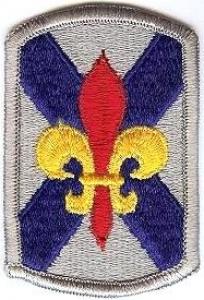Всесвітня військова енциклопедія
> США
> Нашивки
> Нарукавні нашивки Сухопутних військ
> Піхота
> US-INPTUS-00125

Нарукавний знак 256 піхотної бригади СВ США
Випадкові:

Нарукавний знак Командування округу Вашингтон
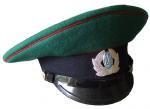
Фуражка рядового, сержанта Государственной Пограничной Службы Украины

320th Cavalry regiment
Змінити інформацію
Description
On a gray rectangular shield with arced top and bottom within a 1/8 inch (.32 cm) gray border 3 inches (7.62 cm) in height and 2 inches (5.08 cm) in width overall, a blue saltire surmounted by a fleur-de-lis the center frond red and the outer fronds and cross-bar gold.
Symbolism
The saltire, symbol used on military maps to represent a brigade, stands for the Organization. In addition, the saltire, which appears on the coat of arms of Nova Scotia and on the Confederate flag, alludes to the Brigade’s home area whose early inhabitants were from Nova Scotia, and to the Confederacy of which Louisiana was a part. The fleur-de-lis, referring to the location of the Brigade’s headquarters at Lafayette, stands for the French background and traditions of that part of the State. The center frond is red in reference to Lafayette’s original name, Vermilionville, and to nearby Bayou Vermilion. The combination of blue, for Infantry and gray, for the Confederacy, with red and gold also alludes to the branch colors for Artillery and various other components of the Brigade. The rectangle shield shape is the traditional shape for shoulder sleeve insignia of brigades.
Background
The shoulder sleeve insignia was originally approved for the 256th Infantry Brigade on 23 July 1968. It was redesignated for the 256th Infantry Brigade Combat Team and amended to update the description on 3 August 2007. (TIOH Drawing Number A-1-500)
On a gray rectangular shield with arced top and bottom within a 1/8 inch (.32 cm) gray border 3 inches (7.62 cm) in height and 2 inches (5.08 cm) in width overall, a blue saltire surmounted by a fleur-de-lis the center frond red and the outer fronds and cross-bar gold.
Symbolism
The saltire, symbol used on military maps to represent a brigade, stands for the Organization. In addition, the saltire, which appears on the coat of arms of Nova Scotia and on the Confederate flag, alludes to the Brigade’s home area whose early inhabitants were from Nova Scotia, and to the Confederacy of which Louisiana was a part. The fleur-de-lis, referring to the location of the Brigade’s headquarters at Lafayette, stands for the French background and traditions of that part of the State. The center frond is red in reference to Lafayette’s original name, Vermilionville, and to nearby Bayou Vermilion. The combination of blue, for Infantry and gray, for the Confederacy, with red and gold also alludes to the branch colors for Artillery and various other components of the Brigade. The rectangle shield shape is the traditional shape for shoulder sleeve insignia of brigades.
Background
The shoulder sleeve insignia was originally approved for the 256th Infantry Brigade on 23 July 1968. It was redesignated for the 256th Infantry Brigade Combat Team and amended to update the description on 3 August 2007. (TIOH Drawing Number A-1-500)
Ще з цієї категорії: Піхота
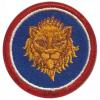 Нарукавний знак 106 піхотної дивізії СВ США
Нарукавний знак 106 піхотної дивізії СВ США
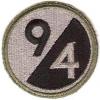 Нарукавний знак 94 навчальної дивізії СВ США
Нарукавний знак 94 навчальної дивізії СВ США
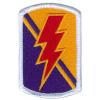 Нарукавний знак 79 піхотної бригадної тактичної групи СВ США
Нарукавний знак 79 піхотної бригадної тактичної групи СВ США
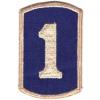 Нарукавний знак 1 піхотної бригади СВ США
Нарукавний знак 1 піхотної бригади СВ США
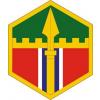 Нарукавний знак 301 бригади бойового забезпечення СВ США
Нарукавний знак 301 бригади бойового забезпечення СВ США

